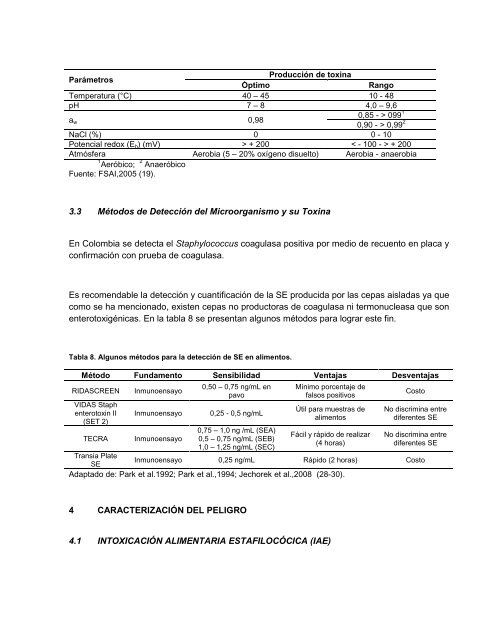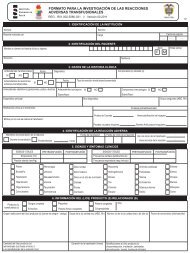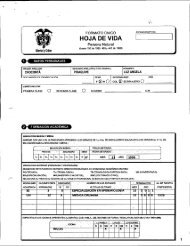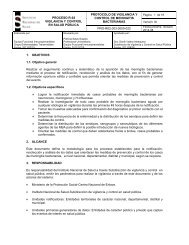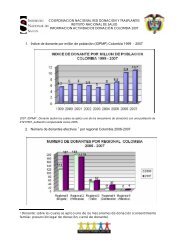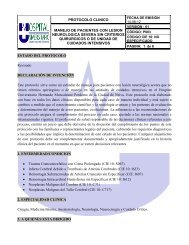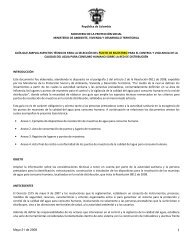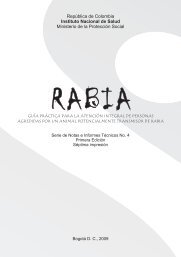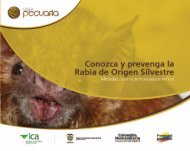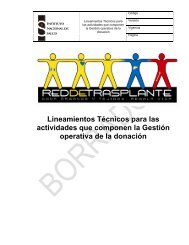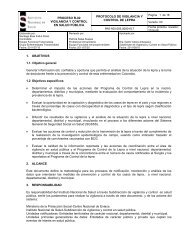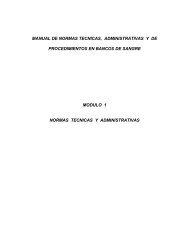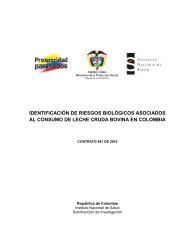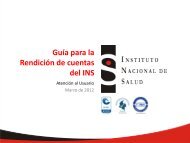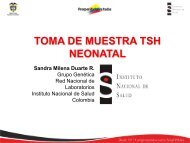er staphylococcus - Instituto Nacional de Salud
er staphylococcus - Instituto Nacional de Salud
er staphylococcus - Instituto Nacional de Salud
You also want an ePaper? Increase the reach of your titles
YUMPU automatically turns print PDFs into web optimized ePapers that Google loves.
Parámetros<br />
Producción <strong>de</strong> toxina<br />
Óptimo Rango<br />
Temp<strong>er</strong>atura (°C) 40 – 45 10 - 48<br />
pH 7 – 8 4,0 – 9,6<br />
aw<br />
0,98<br />
0,85 - > 099 1<br />
0,90 - > 0,99 2<br />
NaCl (%) 0 0 - 10<br />
Potencial redox (Eh) (mV) > + 200 < - 100 - > + 200<br />
Atmósf<strong>er</strong>a<br />
1 2<br />
A<strong>er</strong>óbico; Ana<strong>er</strong>óbico<br />
A<strong>er</strong>obia (5 – 20% oxígeno disuelto) A<strong>er</strong>obia - ana<strong>er</strong>obia<br />
Fuente: FSAI,2005 (19).<br />
3.3 Métodos <strong>de</strong> Detección <strong>de</strong>l Microorganismo y su Toxina<br />
En Colombia se <strong>de</strong>tecta el Staphylococcus coagulasa positiva por medio <strong>de</strong> recuento en placa y<br />
confirmación con prueba <strong>de</strong> coagulasa.<br />
Es recomendable la <strong>de</strong>tección y cuantificación <strong>de</strong> la SE producida por las cepas aisladas ya que<br />
como se ha mencionado, existen cepas no productoras <strong>de</strong> coagulasa ni t<strong>er</strong>monucleasa que son<br />
ent<strong>er</strong>otoxigénicas. En la tabla 8 se presentan algunos métodos para lograr este fin.<br />
Tabla 8. Algunos métodos para la <strong>de</strong>tección <strong>de</strong> SE en alimentos.<br />
Método Fundamento Sensibilidad Ventajas Desventajas<br />
RIDASCREEN Inmunoensayo<br />
VIDAS Staph<br />
ent<strong>er</strong>otoxin II<br />
(SET 2)<br />
TECRA Inmunoensayo<br />
Transia Plate<br />
SE<br />
0,50 – 0,75 ng/mL en<br />
pavo<br />
Inmunoensayo 0,25 - 0,5 ng/mL<br />
0,75 – 1,0 ng /mL (SEA)<br />
0,5 – 0,75 ng/mL (SEB)<br />
1,0 – 1,25 ng/mL (SEC)<br />
Mínimo porcentaje <strong>de</strong><br />
falsos positivos<br />
Útil para muestras <strong>de</strong><br />
alimentos<br />
Fácil y rápido <strong>de</strong> realizar<br />
(4 horas)<br />
Costo<br />
No discrimina entre<br />
dif<strong>er</strong>entes SE<br />
No discrimina entre<br />
dif<strong>er</strong>entes SE<br />
Inmunoensayo 0,25 ng/mL Rápido (2 horas) Costo<br />
Adaptado <strong>de</strong>: Park et al.1992; Park et al.,1994; Jechorek et al.,2008 (28-30).<br />
4 CARACTERIZACIÓN DEL PELIGRO<br />
4.1 INTOXICACIÓN ALIMENTARIA ESTAFILOCÓCICA (IAE)


